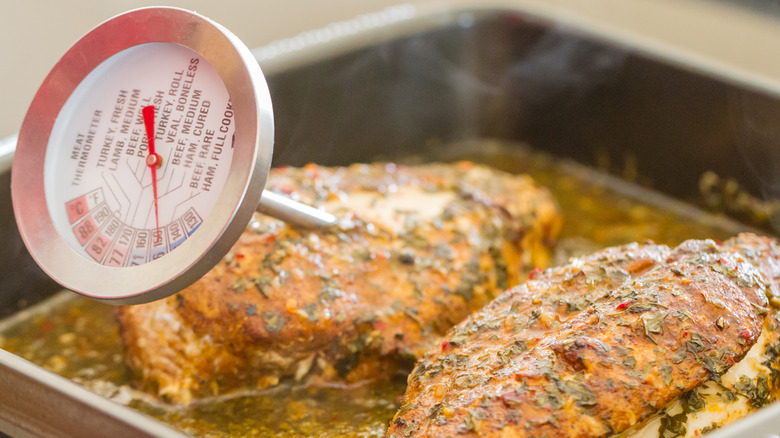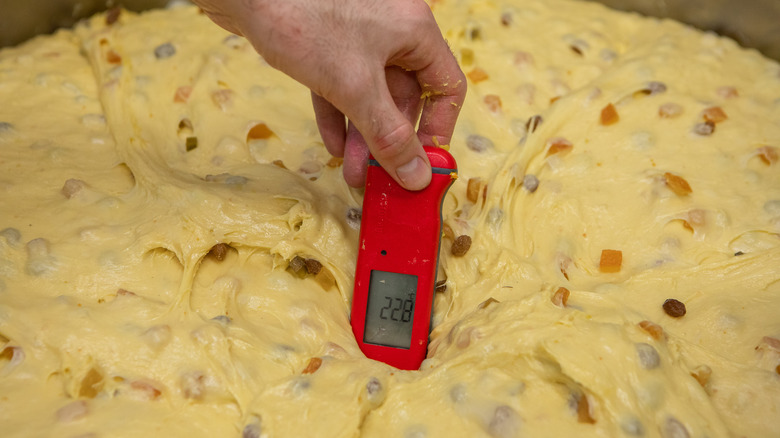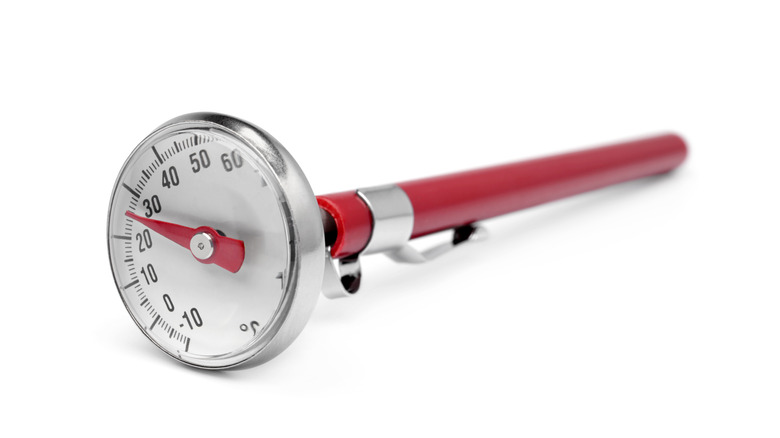The Practical Reason You Should Own More Than One Meat Thermometer
There are a lot of misconceptions about chefs, and one of the biggest is that they cook on instinct alone. This might be an assumption handed down from your parents or grandparents, but it's simply not true. While good cooks have an internal sense of timing (per Bon Appetit), you won't catch any professional putting something in the oven without setting a timer, nor would you witness cooks in a commercial kitchen without a meat thermometer.
Meat thermometers are important tools for chefs for a couple of reasons. First, food safety is a big deal, and while these a handheld quick-read thermometer is designed to take the temperature of meat, a chefs will use one to take the temperature of nearly anything prepared in a kitchen to make sure it is either heated or cooled properly. This can keep food out of "the danger zone" of 40 degrees Fahrenheit and below for chilled items and 140 degrees and higher to prevent foodborne illness. Meat thermometers also prevent over- or undercooking, which is both a waste of money like that spent on overcooked prime rib, or a waste of time like a plate of food returned to the kitchen. Meat thermometers are so common in commercial kitchens that some chef jackets are made with a special small pocket on the upper arm to keep one handy.
Home thermometers and their uses
While health inspectors likely aren't going to be popping by your personal kitchen unannounced like they do at restaurants, it's a good idea to get into the habit of using a meat thermometer at home. It's a pretty inexpensive tool that can make the difference between a show-stopping beef wellington and a tenderloin that is overdone.
Even if you don't cook a lot of meat, however, the thermometers are handy to have around. They take the guesswork out of whether anything is cooked properly or heated to the right temperature, like eggs, soups, and casseroles. They are also indispensable for warming up leftovers. Even with pastries — you can check to see if a cake is cooked through, temper chocolate, and make temperature-sensitive recipes like soufflés.
If you already own at least one meat thermometer and are comfortable using it, having an extra or two could make your life even easier. What's more, different types of thermometers are useful for different purposes.
Thermometers for all occasions
Meat thermometers don't take up a lot of space like extra pots or cake pans, but keeping more than one around will give you some flexibility to do more than one task at a time, like roasting a turkey in the oven while checking the temperature of the green bean casserole for Thanksgiving. It's also useful to have more than one thermometer if you need to juggle varying dietary restrictions. You wouldn't want to use the same thermometer on a pork roast that you use to check a vegetarian dish
Dial thermometers come in a few different models, including the ones that fit into your chef's coat pocket. Those are good for temping a chicken breast or filet mignon on the grill. There are also larger all-metal models, which you can leave in the oven to see how your prime rib is coming along. Instant-read digital thermometers are fairly inexpensive these days and are great for getting a super-fast check on the progress of an ice cream base or crème anglaise, which can curdle in seconds if they're heated just a degree too much.
No matter which model of thermometer you're using, make sure you're inserting it properly to get the most accurate reading. The goal is to find the coldest spot, usually in the center. Insert the probe all the way through to the middle, or, in the case of certain meat cuts, all the way to the bone, and then slowly pull it back out, keeping an eye on the temperature for the lowest number.


